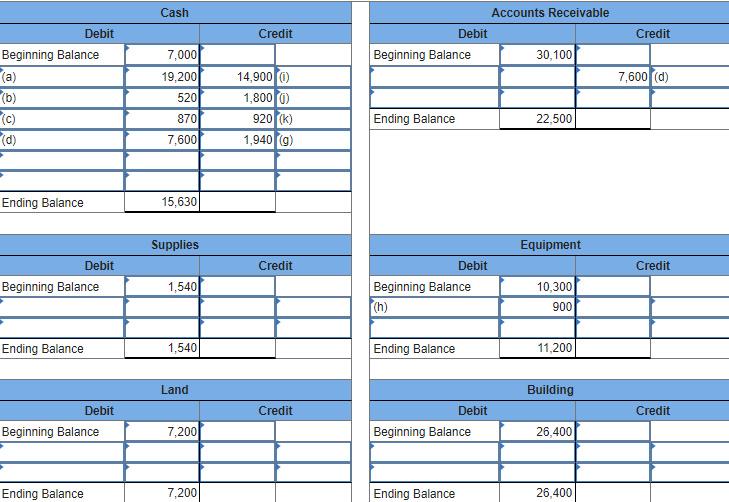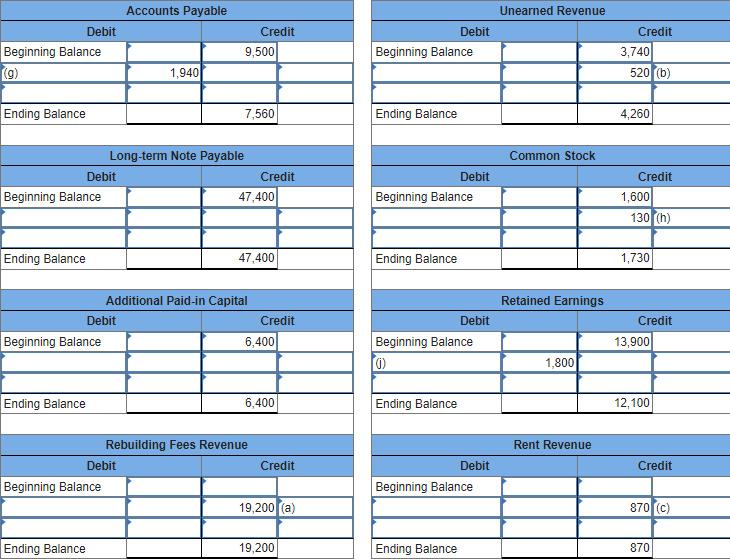Please help





Stacey's Piano Rebuilding Company has been operating for one year. At the start of the second year, its income statement accounts had zero balances and its balance sheet account balances were as follows: Cash Accounts payable $7,000 30,100 $9,500 3,740 Accounts receivable Unearned revenue 1,540 Long-term note payable 47,400 Supplies Equipment Land 10,300 Common stock 1,600 7,200 6,400 Additional paid-in capital Retained earnings Building 26,400 13,900 a. Rebuilt and delivered five pianos in January to customers who paid $19,200 in cash. b. Received a $520 deposit from a customer who wanted her piano rebuilt. c. Rented a part of the building to a bicycle repair shop; received $870 for rent in January. d. Received $7,600 from customers as payment on their accounts. e. Received an electric and gas utility bill for $520 to be paid in February. f. Ordered $920 in supplies. g. Paid $1,940 on account in January. h. Received from the home of Stacey Eddy, the major shareholder, a $900 tool (equipment) to use in the business in exchange for 130 shares of $1 par value stock. i. Paid $14,900 in wages to employees who worked in January. j. Declared and paid a $1,800 dividend (reduce Retained Earnings and Cash). k. Received and paid cash for the supplies in (f). 1. Paid $310 in interest expense on the long-term note payable. Required: 1 and 2. Enter the following transactions for January of the second year into the T-accounts, using the letter of each transaction as the reference: 3. Using the data from the T-accounts, amounts for the following at the end of January of the second year, were: Debit Beginning Balance (a) (b) (C) (d) Ending Balance Beginning Balance Ending Balance Beginning Balance Ending Balance Debit Debit Cash 7,000 19,200 520 870 7,600 15,630 Supplies 1,540 1,540 Land 7,200 7,200 Credit 14,900 (1) 1,800 (0) 920 (k) 1,940 (g) Credit Credit Debit Beginning Balance Ending Balance Beginning Balance Ending Balance Beginning Balance Ending Balance Debit Debit Accounts Receivable 30,100 22,500 Equipment 10,300 900 11,200 Building 26,400 26,400 Credit 7,600 (d) Credit Credit Accounts Payable 1,940 Long-term Note Payable Additional Paid-in Capital Rebuilding Fees Revenue Debit Beginning Balance (g) Ending Balance Beginning Balance Ending Balance Beginning Balance Ending Balance Beginning Balance Ending Balance Debit Debit Debit Credit 9,500 7,560 Credit 47,400 47,400 Credit 6,400 6,400 Credit 19,200 (a) 19,200 Debit Beginning Balance Ending Balance Beginning Balance Ending Balance Beginning Balance (1) Ending Balance Beginning Balance Ending Balance Debit Debit Debit Unearned Revenue Common Stock Retained Earnings 1,800 Rent Revenue Credit 520 (b) 3,740 4,260 Credit 130 (h) 1,600 1,730 Credit 13,900 12,100 Credit 870 (c) 870 Debit Beginning Balance (0) Ending Balance Beginning Balance (1) Ending Balance Debit Wages Expense 14,900 14,900 Interest Expense 310 310 Credit Credit Debit Beginning Balance (e) Ending Balance Utilities Expense 520 520 Credit Using the data from the T-accounts, amounts for the following at the end of January of the second year, were: = Net income Revenues Assets Expenses = Liabilities Stockholder's equity











